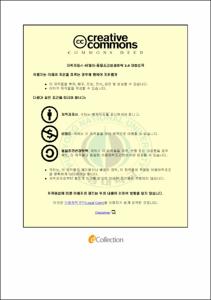유연기판을 이용한 유기 태양전지 제작 및 특성 평가에 관한 연구
- Abstract
- Into the information Age, the importance of electronic display industry is growing. Among them, Flexible organic optoelectronic devices such as organic light emitting diodes (OLEDs) for displays and organic solar cells (OSCs) require that flexible and transparent conducting electrodes (TCEs) having high transparency and conductivity be fabricated on flexible substrates. But, crystal-like indium-doped tin oxide (c-ITO), the material most normally used for TCEs, is not the most suitable for the fabrication of such electrodes for large-area flexible displays because it is brittle and cracks easily under bending stress. Therefore, apply to flexible display require to enhanced TCEs and flexible substrates. In this study, using flexible substrates such as PET, PES, PI and improved bending and electrical characteristics metal grid embedded PI and TCE deposition used DC-RF magnetron sputtering method using ITO target by thickness (20 nm, 100 nm) were deposited, Fabricated samples tested optical, electrical, and bending characteristics. In addition, organic solar cells, structure of flexible substrates (PI or metal grid embedded PI)/ITO/PEDOT: PSS/PBDTTT-C:PC60BM/Al was fabricated. As a result, flexible substrates and ITO deposited flexible substrates transmittance of more than 90%, and the sheet resistance of ITO 20 nm in 250 Ω/cm2, ITO100 nm in 50 Ω/cm2, ITO 20 nm/ metal grid embedded PI in 14 Ω/cm2 were measured and the percentage change in the resistance of the flexible electrode, metal grid embedded PI resistance change was less. The results of the efficiency of organic solar cells, metal grid embedded PI power conversion efficiency (PCE) of 4.006 ± 0.116% up to the cell area of 0.64 cm2 under AM 1.5 (1 sun) simulated illumination with an intensity of 100 mW/cm2 and after bending test, conventional efficiency of 3.5%(3.901% ± 0.124%) was reduced and fabricated large-area cell (50 x 50size) of PCE 2.55% was able to get excellent results.
- Issued Date
- 2013
- Awarded Date
- 2013. 2
- Type
- Dissertation
- Publisher
- 부경대학교
- Affiliation
- 부경대학교 대학원
- Department
- 대학원 고분자공학과
- Advisor
- 김주현
- Table Of Contents
- Contents
List of Figures
List of Tables
Abstract
Chapter I. 서론
I-1. 태양전지의 이해
I-2. 태양전지의 기술동향
I-3. 태양전지에 영향을 주는 주요 요소
I-3-1. 태양전지 효율 (η)
I-3-2. 단락전류 (Jsc)
I-3-3. 개방전압 (Voc)
I-3-4. 곡선인자 (FF)
I-3-5. 최대 출력전류와 최대 출력전압 (Imax, Vmax)
I-3-6. 전류-전압 곡선 (I-V)
I-3-7. 직렬저항 (Rs)
I-3-8. 병렬저항 (Rsh)
I-3-9. 양자효율, 수집효율
I-3-10. 대기질량 (AM)
I-4. 태양전지의 종류
I-4-1. 실리콘 기반의 무기태양전지
I-4-1-1. 결정성 실리콘 태양전지
I-4-1-2. 비정질 실리콘 태양전지
I-4-2. CdTe 태양전지
I-4-3. CIGS(CuInGaSe2) 태양전지
I-4-4. 염료감응형(DSSC) 태양전지
I-4-5. 유기 태양전지
I-5. 유기 태양전지의 이해
I-6. 유기 태양전지의 기술동향
I-7. 플렉시블 디스플레이
Chapter II. 유연기판의 광학적, 전기적 특성 평가
II-1. 서론
II-2. 이론적 배경
II-2-1. 측정방법
II-2-1-1. 광학적, 전기적 분석
II-2-1-2. 굽힘 분석
II-2-1-3. 광전변환 효율 분석
II-2-2. ITO 박막의 형성 및 스퍼터링
II-2-2-1. ITO박막 구조
II-2-2-2. 스퍼터링의 원리
II-2-2-3. DC-RF 마그네트론 스퍼터링
II-2-3 굽힘 시험
II-3. 실험방법
II-3-1. ITO/PET substrate 제작
II-3-2. ITO/PES substrate 제작
II-3-3. ITO/PI substrate 제작
II-3-4. ITO/Metal grid 삽입된 PI substrate 제작
II-3-5. 굽힘 시험
II-4. 결과 및 고찰
II-4-1. 유연기판의 투과도 결과
II-4-2. ITO 박막이 형성된 유연기판의 투과도 및 면저항결과
II-4-3. ITO 박막이 형성된 유연기판의 반경 별 굽힘 시험
II-4-4. ITO 박막이 형성된 유연기판의 순환 굽힘 시험
II-5. 결론
Chapter III. 유연기판을 이용한 유기 태양전지 소자 제작
III-1. 서론
III-2. 유연기판을 이용한 유기 태양전지 소자 제작
III-3. 결과 및 고찰
III-3-1. 유연기판 상의 유기 태양전지 소자 특성 결과
III-3-2. 유연기판 유기 태양전지의 radius 별 굽힘 시험 특성 결과
III-3-3. 유연기판을 이용한 대면적 유기 태양전지 소자 특성 결과
III-4. 결론
Reference
- Degree
- Master
- Files in This Item:
-
-
Download
 유연기판을 이용한 유기 태양전지 제작 및 특성 평가에 관한 연구.pdf
기타 데이터 / 2.54 MB / Adobe PDF
유연기판을 이용한 유기 태양전지 제작 및 특성 평가에 관한 연구.pdf
기타 데이터 / 2.54 MB / Adobe PDF
-
Items in Repository are protected by copyright, with all rights reserved, unless otherwise indicated.